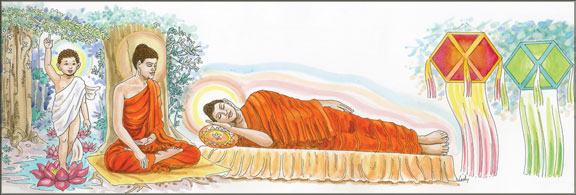Historical context of early Buddhism
Dr Keerthi Jayasekara
 Vesak marks the birth of Prince Siddhartha enlightenment of
Siddhartha Gothama and the passing away, or parinirwana of Gauthama the
Buddha, over 2600 years ago. It is generally agreed among scholars that
Buddhism arose in the sixth century BC during or some what after the
period when the upanishadic doctrins were being formulated. The
upanisads are consieered to form the Thailand of the vedic tradition and
are known as the vedanta or the end of the vedas. Vesak marks the birth of Prince Siddhartha enlightenment of
Siddhartha Gothama and the passing away, or parinirwana of Gauthama the
Buddha, over 2600 years ago. It is generally agreed among scholars that
Buddhism arose in the sixth century BC during or some what after the
period when the upanishadic doctrins were being formulated. The
upanisads are consieered to form the Thailand of the vedic tradition and
are known as the vedanta or the end of the vedas.
In some Buddhist texts we find the phrase. Vedanta-gu-brahmachario,
used to denote a person who has gained the heights of spiritual
knowledge and as such has consummated his religious life. The Buddha was
called a vedagu: one who has mastered the vedas in full. "Education in
Ancient India' by Dr R K Mukerjee states a kshathriya, a warrior caste
member should posses a good knowledge of the Vedas to the extent that he
could teach the Vedas to a Brahmin member of society.
Veda influence
The Buddha says that 'there are these four truths of the Brahmins
which have been realized by me by my own higher knowledge and made known
(Anguttara IV 185: Samyutta XXII.90). He characterizes his Dharma as
ancient (Purana, as eternal Sasvata or sanathana). He compares it to the
discovery of an old buried forgotten city (Nagara Sutta). He is said to
be a knower of the Veda (Vedajna) or of a Vedanta (vedantajna). (Samyutta
1: 168: Sutta Nipata 463). This shows the close relationship between
Upanishadic and early Buddhist thought.
|

Men and women are classified into different psychological
types. Picture by Saman Sri Wedage |
The Upanishads, however to not present a single view, but a variety
of views regarding the nature and destiny of man in the universe.
Upanishadic thinkers considered the earlier imaginative and
discursive type of knowledge as a form of 'lower knowledge' (apara vidya),
while their own knowledge was derived from an expansion of consciousness
and extra sensory powers of perception.
This was due to the practice of yoga and the intuitive knowledge thus
gained was regarded by them as (para vidya) or the ultimate knowledge.
The Buddha, it is said, studied under Yogic teachers presumably of
the vedic tradition such as Alara Kalama and Uddakaramaputta but,
although he mastered their teachings, he is said to have gone away
dissatisfied with them. However, immediately after his enlightenment, he
first thinks of preaching to these two teachers.
Perfect seers
Prof K N Jayathilaka states 'The recognition of the worth of these
Upanishadic teachings in the Buddhist texts is embodied in the stanza
with which Brahma, the regent of the Cosmos, invites the Buddha to
preach the Dhamma to the world, which would otherwise be destroyed
without it. It reads as follows: "there arose in the past among the
magadhan people a Dhamma, which was not perfect and which was conceived
by imperfect seers. Open now the door to immortality so that people may
listen to the Dhamma, which has been fully comprehended by a perfect
one."
"A further recognition of the value of the intuitive insights of some
of the Upanishadic seers is contained in the Buddhist concept of the
Pacceka Buddha, which accepts the fact that one may attain salvation and
a high degree of enlightenment by one's own efforts, without necessarily
depending on the teaching of the Buddha himself. Even the teaching of
the Buddha it may be noted, is only a guide to understanding. "For one
has put forth efforts oneself, for the Transcendent ones are only
guides."
It was the convergence of the two tradition, the vedic and non-vedic,
which blossomed forth in Buddhism. Also towards the end of the vedic
tradition there emerged sincere seekers after truth and immortality, who
devoted their entire lives to this quest, renouncing all else.
This guest begins in the Aranayaka or the Upanishadic period, Prior
to about 800 BC, when we meet with the following prayer recorded in the
Brhadaranayaka Upanisads:
From the unreal, lead me to the real!
From darkness, lead me to light!
From death, lead me to immortality!
It is in answer, as it were to this quest that the Buddha circa 528
BC announced to the world: "Open for them are doors to immortality." And
during the course of time from 800 to 528 BC earnest seekers gave up
everything for this quest."
Way of life
It is also at this time that we discover the world over a new
awakening of the Human race. In Greece, Pythagoras, perhaps influenced
by Eastern thought, conceives of philosophy as a way of life, sets up a
brotherhood and teachers the doctrine of rebirth, which later influenced
Plato, platonic ideas eventually had an impact on Plotinus, St Augustine
and the modern western world.
In Israel, the prophet Isaiah dreams of a time to come when there
shall be Human Brotherhood and all nations shall live in amity and
friendship and wars shall be no more. In India, as we have already seen
Upanishadic seers achieve a breakthrough in Human consciousness and one
of them predicts that truth alone shall conquer and never untruth.
The maitrayani upanishad shows evidence of the influence of Buddhism
although it forbids the Brahmins from studying whatever is not Veda.
Hence, we could regard the period from Rg Veda to the maithrayani
upanishad as the vedic tradition that could have had an impact on the
rise of Buddhism.
Prof K N Jayathilaka says 'the Sutta Nipata says that the sage Asitha
predicted that the Buddha-child was born for the welfare and happiness
of mankind: as H G Wells points out in his a short history of the world,
Gauthama Buddha.... taught his disciples at Benares in India about the
same time that Isaiah was prophesying among the Jews in Babylon....
Isaiah says that a people who walked in darkness have seen a great light
and speaks of a child to be born at the time and who shall be called
wonderful, counsellor, the mighty God, ever lasting father and the
prince of peace. Of the increase of his government and of peace, it is
said, there will be no end."
"It is a curious coincidence that all these epithets have been
claimed by or for the Buddha either during his lifetime of a few
centuries after his birth. For the Buddha says that he is the
Acchariya-Puggala or the wonderful person and satta devamanussanam, the
counsellor of Gods and men, while he has been called "the God among
Gods' (Brahmati brahma, Devatideva), the Eternal father (Adi pita) and
the santiraja or santi-nayaka, the prince of peace. The Buddha himself
says in the Bhayabherava sutta: if any one says that there is born in
this world a perfectly enlightened being for the welfare of mankind out
of compassion for the world, for the welfare and happiness of gods and
men, he may rightly say this of me".
Rule of righteousness
In the Ariyapariyesena sutta, the Buddha speaks of going to kasi to
set up the kingdom of rule of righteousness (Dhamma-chakkam pavattetum),
which is elsewhere called Brahmacakkam or the kingdom of God, but since
Brahma here does not have a theistic connotation, it would mean the
highest or the most sublime Kingdom. And it is said that the gradual
advance of this rule righteousness can not be prevented by any religious
teacher, Angel, Satan (Mara), god (Brahma) or any one in this cosmos."
Prof K N Jayathilaka says "Maitraya Upanishads mentions a sect
wearing a 'Ruddy robe' (Kasaya), which converts people by recourse,
Relational arguments and examples (tarka-drstomta), denies the doctrine
of the soul (nairatmyavada), preaches a Dharma which is destructive of
the vedas and orthodox scriptures and whose goal is the mere attainment
of pleasure (retimatram phalamasya)."
For when the Buddha was asked whether he was a human being,a Brahma
(God) or mara (satan) he denied that he was any of them and claimed that
he was Buddha, ie, An enlightened being who has attain the transcendent.
The Buddha pointed out that what he showed was a way to achieve this
change in motivation by a process of self analysis meditation and self
development. Men and Women are classified into different psychological
types and different forms of meditation are prescribed for them to
achieve this end. An aim of the Buddhist ethics therefore is the
attainment of personal happiness and social harmony."
According to the Buddha what was important was to find a solution to
the problem of human anxiety and suffering rather than be concerned with
the nature of ultimate reality.
Good and true
Prof K N Jayathilaka says "The doctrines of Buddhism can be better
understood if we can seen in them the impact of the different theories
and practices enunciated in the vedic and non-vedic traditions. One of
the basic principles of Buddhism has been that of accepting whatever it
thinks is sound, good and true from whatever source it comes, and of
rejecting what it believed to be unsound, evil and false.
On this principle, we can observe that there are some things which
are acceptable to Buddhism in the vedic tradition and others which are
rejected. It is the same with the theories of the materialists, septics,
Ajirakas and jains in the non-vedic tradition. A careful study of what
is derived from each of these traditions as well as and what is rejected
will help us to comprehend the Dhamma with greater clarity and
precision."
On the occasion on which the Buddha finally passed away into nirvana
Arhath Anuruddha who was by the side of the Buddha described the
parinirvana of the Buddha as," The final liberation of the mind was like
the extinction of a lamp."
The word nirvana, means both 'extinction as well as' the highest
positive experience of happiness."
Nirvana being a state beyond space, time and causation it can not be
conceptually apprehended, since all our concepts are derived from the
framework of the space-time-cause equation. |





